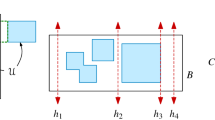Abstract
A well-known problem in computational geometry is Klee’s measure problem, which asks for the volume of a union of axis-aligned boxes in d-space. In this paper, we consider Klee’s measure problem for the special case where a 2-dimensional orthogonal projection of all the boxes has a common corner. We call such a set of boxes 2-grounded and, more generally, a set of boxes is k-grounded if in a k-dimensional orthogonal projection they share a common corner.
Our main result is an O(n (d−1)/2log2 n) time algorithm for computing Klee’s measure for a set of n 2-grounded boxes. This is an improvement of roughly \(O(\sqrt{n})\) compared to the fastest solution of the general problem. The algorithm works for k-grounded boxes, for any k≥2, and in the special case of k=d, also called the hypervolume indicator problem, the time bound can be improved further by a logn factor. The key idea of our technique is to reduce the d-dimensional problem to a semi-dynamic weighted volume problem in dimension d−2. The weighted volume problem requires solving a combinatorial problem of maintaining the sum of ordered products, which may be of independent interest.







Similar content being viewed by others
Notes
x d denotes the dth coordinate of point x.
This name is inspired by color gradients, which are images with decreasing color intensity in one direction.
Note that \(\sum_{k=1}^{d}{{d-1\choose{k-1}} \times(k-1)!} = \sum_{k=0}^{d-1}{\frac{(d-1)!}{(d-1-k)!}} = \sum_{k=0}^{d-1}{\frac{(d-1)!}{k!}} \le\mathtt{e}(d-1)! \).
Since we assume that all halfspaces have distinct weights, all inner terms that contain equal indices are 0, and so we can safely ignore these terms and use a strict ordering on indices i 2,…,i k .
For simplicity of presentation only, we use a non-strict ordering of the array indices (i.e., i 1≤⋯≤i d ) in this lemma. The sum of products with strictly ordered indices (i.e., i 1<⋯<i d , as defined in Sect. 4.2) can be easily reduced to this form by shifting arrays. In particular, the strictly ordered sum of products for d arrays \(\mathcal{A} _{1},\ldots , \mathcal{A} _{d}\) is equal to the non-strictly ordered sum of products for arrays \(\mathcal {A} '_{1},\ldots, \mathcal{A} '_{d}\) where \(\mathcal{A} '_{s}[i]\) is defined to as \(\mathcal{A} _{s}[i+s-1]\).
In d dimensions, an axis-parallel strip has the form \(\{{\mathbf {x}}\in \mathbb{R} ^{d} \mid a \le{\mathbf{x}}^{k} \le b \}\) where a and b are reals and k is an integer between 1 and d.
References
Agarwal, P.: An improved algorithm for computing the volume of the union of cubes. In: Proceedings of the 26th Annual Symposium on Computational Geometry, pp. 230–239 (2010)
Agarwal, P., Kaplan, H., Sharir, M.: Computing the volume of the union of cubes. In: Proceedings of the 23rd Annual Symposium on Computational Geometry, pp. 294–301 (2007)
Bentley, J.L.: Solutions to Klee’s rectangle problems. Unpublished manuscript (1977)
de Berg, M., Cheong, O., van Kreveld, M., Overmars, M.: Computational Geometry: Algorithms and Applications. Springer, Berlin (2008)
Bringmann, K.: Klee’s measure problem on fat boxes in time O(n (d+2)/3). In: Proceedings of the 26th Annual Symposium on Computational Geometry, pp. 222–229 (2010)
Bringmann, K., Friedrich, T.: Approximating the volume of unions and intersections of high-dimensional geometric objects. In: Proceedings of 19th International Symposium on Algorithms and Computation, pp. 436–447 (2008)
Chan, T.: Semi-online maintenance of geometric optima and measures. In: Proceedings of the 13th Annual ACM-SIAM Symposium on Discrete Algorithms, pp. 474–483 (2002)
Chan, T.M.: A (slightly) faster algorithm for Klee’s measure problem. Comput. Geom. 43(3), 243–250 (2010)
Chew, L., Dor, D., Efrat, A., Kedem, K.: Geometric pattern matching in d-dimensional space. Discrete Comput. Geom. 21(2), 257–274 (1999)
Fleischer, M.: The measure of Pareto optima. Applications to multi-objective metaheuristics. In: Evolutionary Multi-criterion Optimization, Second International Conference, pp. 519–533 (2003)
Fonseca, C., Paquete, L., López-Ibáñez, M.: An improved dimension-sweep algorithm for the hypervolume indicator. In: IEEE Congress on Evolutionary Computation, pp. 1157–1163 (2006)
Huband, S., Hingston, P., While, L., Barone, L.: An evolution strategy with probabilistic mutation for multi-objective optimisation. In: The 2003 Congress on Evolutionary Computation, vol. 4, pp. 2284–2291 (2003)
Kaplan, H., Rubin, N., Sharir, M., Verbin, E.: Counting colors in boxes. In: Proceedings of the 18th Annual ACM-SIAM Symposium on Discrete Algorithms, pp. 785–794 (2007)
Klee, V.: Can the measure of \(\bigcup_{1}^{n}[a_{i},b_{i}]\) be computed in less than O(nlogn) steps? Am. Math. Mon. 84(4), 284–285 (1977)
van Leeuwen, J., Wood, D.: The measure problem for rectangular ranges in d-space. J. Algorithms 2(3), 282–300 (1981)
Overmars, M.H., Yap, C.K.: New upper bounds in Klee’s measure problem. SIAM J. Comput. 20(6), 1034–1045 (1991)
Zitzler, E., Künzli, S.: Indicator-based selection in multiobjective search. In: Proceedings of 8th International Conference on Parallel Problem Solving from Nature, pp. 832–842 (2004)
Author information
Authors and Affiliations
Corresponding author
Rights and permissions
About this article
Cite this article
Yıldız, H., Suri, S. Computing Klee’s Measure of Grounded Boxes. Algorithmica 71, 307–329 (2015). https://doi.org/10.1007/s00453-013-9797-9
Received:
Accepted:
Published:
Issue Date:
DOI: https://doi.org/10.1007/s00453-013-9797-9




